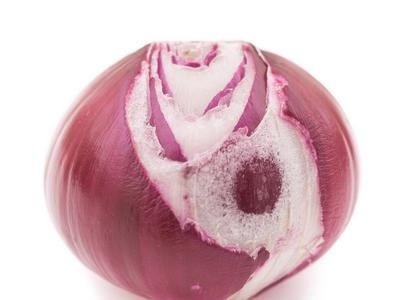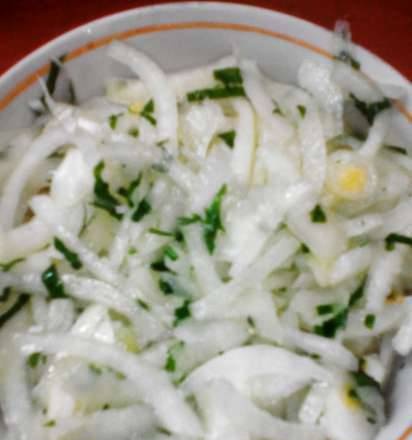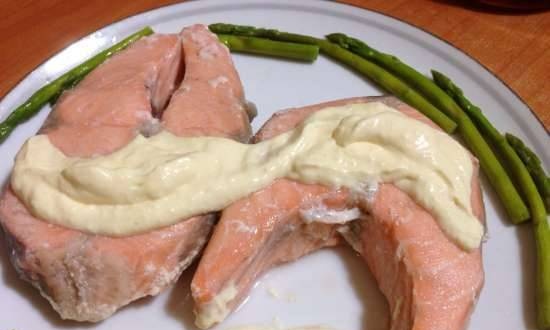|
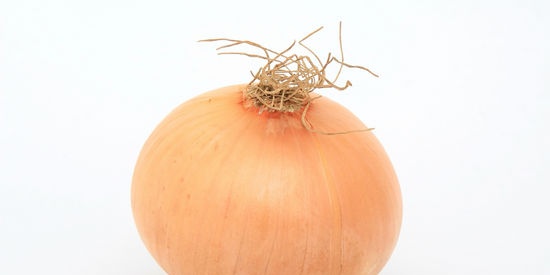 Onions can be grown in any area, but appropriate conditions must be created for this. Onions can be grown in any area, but appropriate conditions must be created for this.
The best for onions are soils rich in organic matter, medium light and sufficiently moist, as well as alluvial and silty-clayey soils. Sandy soils, with a good dressing with organic fertilizers, provide an earlier yield of marketable onions. The soils are moist, heavy and cold, as well as acidic without corresponding radical improvement, cannot be used for onion cultivation. In the first stages of development, onions are quite demanding on moisture, therefore, in conditions of insufficient moisture, additional irrigation is necessary.
In order to avoid the spread of diseases and damage by pests, the return of onions to the same place is allowed no earlier than 3 years later on the 4th, and sowing of onions on the set no earlier than 5 years later on the 6th.
The predecessors of onions can be: cabbage, cucumbers, tomatoes; it is good to sow onions also on fertilized plots for winter crops.
Growing onion sets
The best, most fertile area in the crop rotation field is allocated for onion sets. Sevok is placed in the second year after the application of organic fertilizers.
It is recommended to sand onion seeds in the same way as carrot seeds, or to bring them to the stage of complete swelling. To do this, the seeds are soaked in water for 2 hours, then, slightly moistened, are kept for 3-4 days at a temperature of 10 °, well ventilated, and before sowing they are dried to a state of good flowability and in this form are sown with a seeder.

Sowing of onions for sowing is carried out after tillage: sown with ribbons, 5-6 rows in a ribbon, with a distance between rows in a ribbon of 6-8 cm and between ribbons of 50-60 cm. , with manure or aerated peat in a layer of 2-3 cm. Seeds are planted to a depth of 2-2.5 cm. The seeding rate per hectare is 60 kg, and for spread sowing - 70 kg. If you want to get small seeding, then the seeding rate must be increased to 80-90 kg per hectare, and to obtain larger seeding, the seeding rate is reduced to 50 kg per hectare. Sowing of onions for sets is carried out on a plot with a southern slope and, if possible, earlier.
After the mass emergence of seedlings, if mulching was not used, loosening of narrow aisles and a shelf in rows is performed. Narrow aisles are loosened with hand hoes, and wide ones with cultivators. During the summer, 4-6 looseings and shelves are given.
Onion sets must be harvested no later than the first half of August.
Onion sets are harvested only by hand. The seedlings selected from the ground are laid out in a thin layer for 8-10 days in the field in the beds, and then transferred to the sheds, where they are crumbled to dry in a layer of 10-15 cm. During drying, the onions are tedd up daily and covered with mats in the evening during severe night cold. The rooms must be well ventilated during drying. A well-dried onion set should have a thin, dry neck and 1-2 dry colored scales.
Drying lasts for 10-15 days. When backfilling for storage, the seedlings are subjected to bulkhead and pruning; the neck is left at 3-5 cm.
Growing onions from sets
The onion yield is highly dependent on the quality of the planting material. The best planting material is a set with a diameter of about 1.5-2 cm, and weighing from 1.5 to 3 g. If during the winter the onion set was stored at a temperature of 18-20 °, then it is not heated before planting. If in winter the set was stored at a temperature of 0 or 2 °, then before planting it is heated at a temperature of 30-35 ° for 15 days.
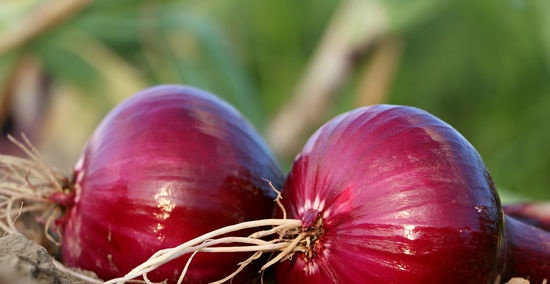
Turnip onions can be grown in the first or second year after the introduction of organic fertilizers (manure, garbage and peat-feces) into the soil, depending on the state of soil fertility and filling it with organic substances, and on soils rich in organic matter, in the second year after fertilizers, in this case, it is recommended to apply mineral fertilizers under the onion at the rate of: ammonium nitrate 1.5 quintals per hectare, superphosphate from 3 to, 5 quintals and potash 40% salt 1.5-2 quintals. Organic fertilizers are applied in spring for cultivation. Instead of potassium salt, ash can be added under onions in an amount of 7-10 centners per hectare. On soils of average fertility, half-decomposed manure must be applied in an amount of 30-50 tons per hectare.
To obtain high yields, onion turnips require a large amount of nutrients. But the simultaneous application of high doses of fertilizers has a negative effect, therefore, part of the mineral fertilizers (smaller) of the recommended above amounts is applied before planting; the rest of the mineral fertilizers are applied during the period of plant growth in the form of dressings. The first feeding is given at the very beginning of head formation; fertilizers are applied into grooves 5–6 cm deep at a distance of 8–10 cm from the row on both sides of the belt; the second feeding 20-25 days after the first. Fertilizers are applied in the middle of the row spacing to a depth of 10-12 cm. After each top dressing, the grooves are leveled.
For the first feeding of onions, 15 g of ammonium nitrate, 30 g of superphosphate and 20 g of potassium salt are dissolved in 1 bucket of water, and for the second, 30 g of ammonium nitrate, 80 g of superphosphate and 40 g of potassium salt are taken for one bucket of water. One bucket of solution is consumed for 8-10 m of a row.
For the first feeding, you can use slurry, bird droppings. For the preparation method of slurry and poultry droppings, see the Cabbage section. Watering rate is 1.5 liters per linear meter.
Planting onion sets
Planting onion sets is carried out early (after sowing nigella), under a marker, on a flat surface, two-line, the distance between the ribbons is taken 50 cm, between the lines in the ribbons - 20 cm and between the plants in a row - 6 cm (for planting, if the bulb up to 1.5 cm in diameter). Approximately 477 thousand pieces of seed plants are required per hectare, or 600 kg by weight. If a larger seed is taken, then the planting rate increases, but not in proportion to the weight of the seed, but somewhat less, since larger seedlings need to be planted in a row less often, at a distance of 7-10 cm. Depending on the fertility of the soil, the distance between the plants can change. On highly fertile soils, planting is carried out more often, on poorly fertile soils, more rarely, but at least 10 cm between plants in a row.

Planting onion sets on the beds is necessary in cases where the groundwater is close to the soil surface (about a meter) or on heavy and moist soils. When planting on ridges, the degree of soil fertility and the size of the planting material are also taken into account; with small planting material, the distance is taken 12 by 12 cm, and with large planting material, 20 by 20 cm between the bulbs.
The onions are planted manually on the track of the marker. The sevok sits in the prepared grooves so that the neck of the bulb is covered with soil to a depth of 0.5 cm. After planting, loosening of wide row spacings is carried out, and then as a crust forms and weeds appear, but not less than 4 times per summer. Inter-row tillage is carried out by multi-row cultivators equestrian and tractor or single-row equestrian. A shelf in rows is made before cultivation as weeds appear, but not less than 3 times a summer. In the first half of growth, when the green mass begins to grow, watering is carried out with the obligatory subsequent loosening of the soil.
Onions are ready for harvesting in 3-3.5 months after planting. But, regardless of the state of maturity, it must be harvested no later than the first half of August. The onion is pulled out and immediately laid out in the field for drying in 2-row belts and dried for several days.If the weather is unstable, then after a little drying it is immediately transported to a covered, well-ventilated room. Depending on maturity, onions are dried for 10 to 15 days. After the complete withering away of the tops and roots, you should start trimming the remains: leaves and roots. The roots are completely removed, and the leaves are left on the neck bulb 1-2 cm long.
Before backfilling for storage, onions must be smoked for 5-7 days: they are placed on shelves in a layer of 10-12 cm, and for the first 5 days the room temperature is from 25 to 30 °, after which the room is thoroughly ventilated by drafts for 2 days ... After 2 days of airing, smoking; repeats. Onions are considered ready for storage when they acquire a dense dark skin, after which they are poured into permanent winter storage.
Growing onions from seeds
For growing turnip onions directly from seeds, small-child varieties are selected. We recommend Kaba and all other sweet varieties. The growing season with this method is lengthened in comparison with the period of growing onions from seedlings. Seeds are first sown in greenhouses. It turns out seedlings. She is planted in the field.
The field provides good conditions for onion growth. For this purpose, a highly fertile site is selected in an appropriate crop rotation field with light soils and early freeing from under the snow.

The site is fertilized. Rotted manure is introduced in the amount of 20-30 tons per hectare and additionally mineral fertilizers in the same doses as for onion sets per turnip. Humus and 2/3 of mineral fertilizers are applied in autumn and the rest of Vs — in spring, under the first shallow spring tillage (harrowing, or cultivation).
Seeds before sowing are processed in the same way as indicated when growing seedlings. Seeds are sown in greenhouses in rows at a distance of 2-4 cm 1.5-2 months before the seedlings are planted in the ground. The seeding rate is 25 g of seeds per 1 frame. Until the seeds fully germinate, the soil in the greenhouses is kept moist. Greenhouses are well ventilated, the temperature is maintained at about 15 °. In places of thickening of seedlings, thinning is carried out, leaving distances between plants of 1-1.5 cm. Shelf and watering is carried out.
By the time of planting in the ground (second decade of May), the seedlings should have 3 leaves. When planting, the same distance in rows is observed as when planting onion sets. The seedlings are planted so that only the roots are in the ground, and the root collar is at the top. Deep planting delays the normal development of the bow. During planting, the seedlings are watered at the rate of 1 bucket of water per 30 plants.
Further care is no different from caring for onion sets planted to obtain a turnip.
Harvesting of onions grown from seeds is carried out simultaneously with harvesting of onions grown from seedlings.
I. Osipov - Agroindication
|
 Onions can be grown in any area, but appropriate conditions must be created for this.
Onions can be grown in any area, but appropriate conditions must be created for this.



